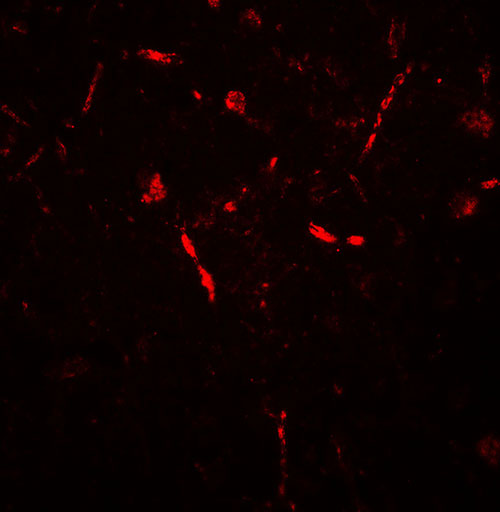APPBP2 Antibody
- 产品详情
- 实验流程
- 背景知识
Application
| WB, IF, E, IHC-P |
|---|---|
| Primary Accession | Q92624 |
| Other Accession | NP_006371, 18104962 |
| Reactivity | Human, Mouse, Rat |
| Host | Rabbit |
| Clonality | Polyclonal |
| Isotype | IgG |
| Calculated MW | 66853 Da |
| Concentration (mg/ml) | 1 mg/mL |
| Conjugate | Unconjugated |
| Application Notes | APPBP2 antibody can be used for detection of APPBP2 by Western blot at 0.5 - 1 µg/ml. Antibody can also be used for Immunohistochemistry starting at 5 µg/mL. For immunofluorescence start at 20 µg/mL. |
| Gene ID | 10513 |
|---|---|
| Other Names | Amyloid protein-binding protein 2, Amyloid beta precursor protein-binding protein 2, APP-BP2, Protein interacting with APP tail 1, APPBP2, KIAA0228, PAT1 |
| Target/Specificity | APPBP2; APPBP2 antibody is human, mouse and rat reactive. At least two isoforms of APPBP2 are known to exist; this antibody will detect both isoforms. |
| Reconstitution & Storage | APPBP2 antibody can be stored at 4℃ for three months and -20℃, stable for up to one year. |
| Precautions | APPBP2 Antibody is for research use only and not for use in diagnostic or therapeutic procedures. |
| Name | APPBP2 {ECO:0000303|PubMed:26138980, ECO:0000312|HGNC:HGNC:622} |
|---|---|
| Function | Substrate-recognition component of a Cul2-RING (CRL2) E3 ubiquitin-protein ligase complex of the DesCEND (destruction via C-end degrons) pathway, which recognizes a C-degron located at the extreme C terminus of target proteins, leading to their ubiquitination and degradation (PubMed:29775578, PubMed:29779948). The C-degron recognized by the DesCEND pathway is usually a motif of less than ten residues and can be present in full-length proteins, truncated proteins or proteolytically cleaved forms (PubMed:29775578, PubMed:29779948). The CRL2(APPBP2) complex specifically recognizes proteins with a -Arg-Xaa- Xaa-Gly degron at the C-terminus, leading to their ubiquitination and degradation (PubMed:29775578, PubMed:29779948). The CRL2(APPBP2) complex mediates ubiquitination and degradation of truncated SELENOV selenoproteins produced by failed UGA/Sec decoding, which end with a -Arg-Xaa-Xaa-Gly degron (PubMed:26138980). May play a role in intracellular protein transport: may be involved in the translocation of APP along microtubules toward the cell surface (PubMed:9843960). |
| Cellular Location | Nucleus. Cytoplasm, cytoskeleton. Membrane; Peripheral membrane protein. Note=Associated with membranes and microtubules. |
For Research Use Only. Not For Use In Diagnostic Procedures.
Provided below are standard protocols that you may find useful for product applications.
BACKGROUND
The amyloid beta precursor protein (cytoplasmic tail) binding protein 2 (APPBP2), also known as PAT1, interacts with microtubules and is functionally associated with beta-amyloid precursor protein transport and/or processing (1). The beta-amyloid precursor protein is a cell surface protein with signal-transducing properties, and it is thought to play a role in the pathogenesis of Alzheimer's disease (2). APPBP2 has been found to be highly expressed in breast cancer (3).
REFERENCES
Zheng P, Eastman J, Vande Pol S, et al. PAT1, a microtubule-interacting protein, recognizes the basolateral sorting signal of amyloid precursor protein. Proc. Natl. Acad. Sci. USA 1994; 95:14745-50.
Selkoe DJ. Cell biology of the amyloid beta-protein precursor and the mechanism of Alzheimer's disease. Annu. Rev. Cell Biol. 1994; 10:373-403.
Li J, Yang Y, Peng Y, et al. Oncogenic properties of PPM1D located within a breast cancer amplification epicenter at 17q23. Nat. Genet. 2002; 31:133-4.
终于等到您。ABCEPTA(百远生物)抗体产品。
点击下方“我要评价 ”按钮提交您的反馈信息,您的反馈和评价是我们最宝贵的财富之一,
我们将在1-3个工作日内处理您的反馈信息。
如有疑问,联系:0512-88856768 tech-china@abcepta.com.























 癌症的基本特征包括细胞增殖、血管生成、迁移、凋亡逃避机制和细胞永生等。找到癌症发生过程中这些通路的关键标记物和对应的抗体用于检测至关重要。
癌症的基本特征包括细胞增殖、血管生成、迁移、凋亡逃避机制和细胞永生等。找到癌症发生过程中这些通路的关键标记物和对应的抗体用于检测至关重要。 为您推荐一个泛素化位点预测神器——泛素化分析工具,可以为您的蛋白的泛素化位点作出预测和评分。
为您推荐一个泛素化位点预测神器——泛素化分析工具,可以为您的蛋白的泛素化位点作出预测和评分。 细胞自噬受体图形绘图工具为你的蛋白的细胞受体结合位点作出预测和评分,识别结合到自噬通路中的蛋白是非常重要的,便于让我们理解自噬在正常生理、病理过程中的作用,如发育、细胞分化、神经退化性疾病、压力条件下、感染和癌症。
细胞自噬受体图形绘图工具为你的蛋白的细胞受体结合位点作出预测和评分,识别结合到自噬通路中的蛋白是非常重要的,便于让我们理解自噬在正常生理、病理过程中的作用,如发育、细胞分化、神经退化性疾病、压力条件下、感染和癌症。








